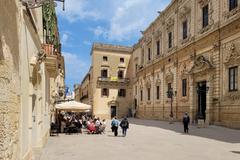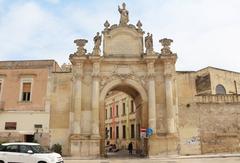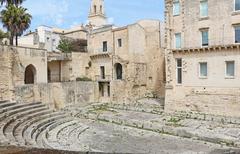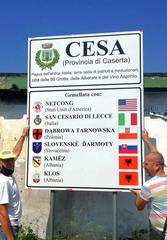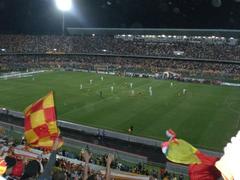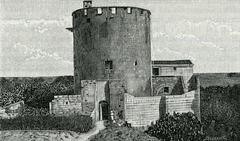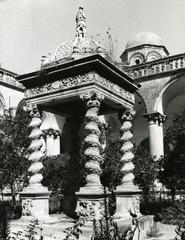Museo Del Teatro Romano: Complete Guide to Visiting Hours, Tickets, and Lecce Historical Sites
Date: 14/06/2025
Introduction
Nestled in the heart of Lecce, Italy, the Museo Del Teatro Romano offers a remarkable window into the city’s ancient Roman heritage. Connected to the archaeological remains of Lecce’s Roman theatre—originally built during the Augustan period—the museum is a focal point for history enthusiasts, architecture lovers, and curious travelers alike. The site, rediscovered in 1929 and now housed within a 17th-century palazzo, presents an engaging journey through time, blending Roman, Baroque, and modern influences into a unique cultural experience. This guide provides comprehensive information on visiting hours, tickets, guided tours, accessibility, and nearby attractions to help you make the most of your visit to Lecce’s premier historical site.
For accurate, up-to-date details, consult resources such as Nomads Travel Guide, Musei Puglia, and Lonely Planet.
Table of Contents
- Introduction
- Historical Significance and Discovery
- Architectural Features
- Museum Layout & Exhibits
- Visiting Hours & Tickets
- Guided Tours & Visitor Experience
- Accessibility & Facilities
- Nearby Attractions & Travel Tips
- Preservation, Events, and Education
- Frequently Asked Questions (FAQ)
- Summary & Visitor Recommendations
- Official Sources
Historical Significance and Discovery
Roman Origins
The Roman theatre of Lecce, dating to the Augustan era (late 1st century BCE–early 1st century CE) and later enhanced during the Antonine period (138–182 CE), was a central venue for public entertainment—hosting comedies, tragedies, and civic ceremonies. With a capacity for up to 5,000 spectators, it reflected the importance of Lupiae (ancient Lecce) within Roman southern Italy (Nomads Travel Guide).
Rediscovery and Museum Establishment
Hidden beneath centuries of urban development, the theatre was uncovered in 1929 during renovations at the Palazzo D’Arpe and Palazzo Romano. Excavations revealed a treasure trove of statues, architectural fragments, and decorative elements, all now preserved and displayed within the adjacent 17th-century palazzo (Lonely Planet).
Architectural Features
The theatre is an outstanding example of Roman civic architecture, with a semicircular cavea divided into six cunei (wedges) and twelve steps, reflecting Roman social stratification. The orchestra, reserved for choirs and dignitaries, is accessed by a narrow gallery, while a series of limestone steps and a low wall separated the stage from the audience.
The entire structure is carved from Lecce stone, a soft, golden local limestone also used in Lecce’s Baroque monuments. This material allowed for intricate detailing, linking Roman and later Baroque craftsmanship (London City Calling).
Museum Layout & Exhibits
Setting and Atmosphere
The museum is compact but thoughtfully curated, with original stonework and period features providing context. Exhibits are organized chronologically and thematically, guiding visitors from the theatre’s rediscovery through its cultural legacy.
Permanent Exhibitions
- Archaeological Finds: Statuary fragments, capitals, friezes, ceramics, oil lamps, and everyday items, all discovered on-site.
- “Roma. La scena della vita”: An exploration of Roman theatrical scenography, featuring masks from Villa Adriana in Tivoli, stage design reconstructions, and costume replicas (Puglia.com).
- Urban Reconstruction: Scale models reconstruct the layout of Roman Lupiae, contextualizing the theatre’s place in the ancient city.
- Multimedia & Interactive Panels: Videos, touchscreen maps, and timelines enrich the experience for all ages.
Visiting Hours & Tickets
- Opening Hours: Generally Tuesday to Sunday, 9:00 AM–7:00 PM (last entry at 6:30 PM). Closed Mondays and select holidays. Some sources list Monday–Saturday, 09:30–13:00, with afternoons by reservation (Ostuni the White City). Always confirm before your visit.
- Tickets: Standard admission is typically €5–€6, with discounts for students, seniors, and groups. Children under 18 and local residents may qualify for free entry. Combined tickets for other sites are sometimes available.
- Purchase Options: Tickets can be bought at the entrance or online via the official site or cultural portals.
Guided Tours & Visitor Experience
- Guided Tours: Available in Italian and English, these tours provide expert insights into Roman theatre, architecture, and the museum’s archaeological finds. Advance booking is strongly recommended, especially for groups or afternoon visits (Audiala).
- Tour Highlights: In-depth exploration of the theatre’s cavea, orchestra, and stage; context on performance arts; and connections to broader Roman society.
Accessibility & Facilities
- Accessibility: The museum and theatre are partially accessible, with ramps and elevators in the main building. Some archaeological areas may be uneven or have limited access for those with mobility impairments (Audiala).
- Facilities: Restrooms, a small gift shop, and bilingual interpretive panels are available. Audio guides and multimedia displays enhance accessibility for visually impaired visitors.
Nearby Attractions & Travel Tips
- Roman Amphitheater: Located in Piazza Sant’Oronzo, the larger amphitheater complements the museum visit (Atlas Obscura).
- Lecce Cathedral & Baroque Sites: The city center is rich with ornate churches and palaces, all within walking distance.
- MUST – Museo Storico della Città di Lecce: Offers a broader look at Lecce’s history (Ostuni the White City).
- Seasonal Events: Summer months often feature concerts and performances in the theatre, continuing its legacy as a cultural hub.
Visitor Tips:
- Morning visits are quieter; book ahead for guided tours.
- Non-flash photography is permitted in most areas.
- Bring sun protection or a jacket, depending on the season.
- Check the latest health and safety protocols before visiting.
Preservation, Events, and Education
The museum is committed to ongoing conservation and public engagement, with educational workshops, temporary exhibitions, and partnerships with local schools and universities (WhichMuseum). The theatre’s use for live events sustains its role as a gathering place for arts and community.
Frequently Asked Questions (FAQ)
Q: What are the Museo del Teatro Romano’s visiting hours?
A: Typically Tuesday–Sunday, 9:00 AM–7:00 PM; some listings state Monday–Saturday, 09:30–13:00 with afternoons by reservation. Closed on Mondays and holidays. Check the official website for exact times.
Q: How much do tickets cost?
A: Standard tickets are €5–€6, with discounts for certain groups. Combined tickets may be available.
Q: Are guided tours offered?
A: Yes, in multiple languages. Advance booking is recommended.
Q: Is the museum accessible?
A: Main areas are accessible; some archaeological sections may require assistance.
Q: Can I take photos?
A: Non-flash photography is usually allowed; follow posted guidelines.
Q: Are cultural events held at the theatre?
A: Yes, especially during summer, including concerts and performances.
Summary & Visitor Recommendations
The Museo Del Teatro Romano is a must-see destination that immerses visitors in Lecce’s Roman and Baroque heritage. Its central location, engaging exhibits, and ongoing cultural programming make it ideal for families, groups, and solo travelers. Plan ahead by checking visiting hours, booking tours, and exploring nearby historical sites to enrich your experience. Utilize resources such as audio guides, mobile apps, and official tourism portals for the most current information.
For comprehensive details and the latest updates, refer to Audiala, Puglia.com, and WhichMuseum.
Official Sources and Further Reading
- Nomads Travel Guide
- Musei Puglia
- Puglia.com
- Audiala
- Lonely Planet
- WhichMuseum
- Atlas Obscura
- London City Calling
For additional information, tickets, and updates, visit the Museo del Teatro Romano Lecce official page or contact the museum directly.
